Supermarkets are cunning in their efforts to manipulate consumer behavior and entice shoppers to spend more money. Understanding the deceptive tactics employed by grocery stores can help you stay alert and make more informed shopping decisions. By being aware of these tricks, you can protect your wallet and prevent unnecessary impulse buys.
In this article, we will reveal some of the most common grocery store tricks and shed light on the strategies supermarkets employ to influence your purchasing behavior. From strategic store layouts to tempting impulse items, we’ll expose the tactics that can lead you astray when shopping for groceries.
Table of Contents
Placing Essential Items at the Back of the Store
When you enter a grocery store, have you ever noticed how essential items like milk and dairy products are always located at the back of the store? This strategic placement is not a coincidence. Supermarkets employ this tactic to influence your shopping behavior and increase their sales.
By placing essential items at the back of the store, supermarkets force shoppers to navigate through the entire store. As you walk to the back, you pass aisles filled with tempting products and eye-catching displays. This layout is designed to tempt you into making extra purchases along the way. You might find yourself picking up snacks, drinks, or other items that you hadn’t initially planned to buy. The supermarket subtly triggers your impulse to explore and discover more products.
This grocery store layout is a psychological manipulation technique known as the “forced path.” It encourages you to spend more time in the store and exposes you to a wider range of products, increasing the likelihood of making additional purchases. The more products you see, the more chances the supermarket has to entice you with their offerings.
Additionally, this layout benefits supermarkets by maximizing sales and increasing the average basket size. When you spend more time wandering through the store, you become more receptive to marketing messages and promotions. This can lead to higher overall spending during your shopping trip. Supermarkets capitalize on your willingness to explore and exploit it to their advantage.
If you find yourself being lured into making unnecessary purchases, it’s essential to be aware of this strategic layout and take steps to resist the impulse. Creating a shopping list and sticking to it can help you stay focused on your intended purchases. By planning your route through the store and being mindful of the supermarket’s tactics, you can make more informed shopping decisions and resist unnecessary spending. Don’t let the supermarket’s layout dictate your choices; take control of your shopping experience.
Discount Tricks with Multiple Purchases
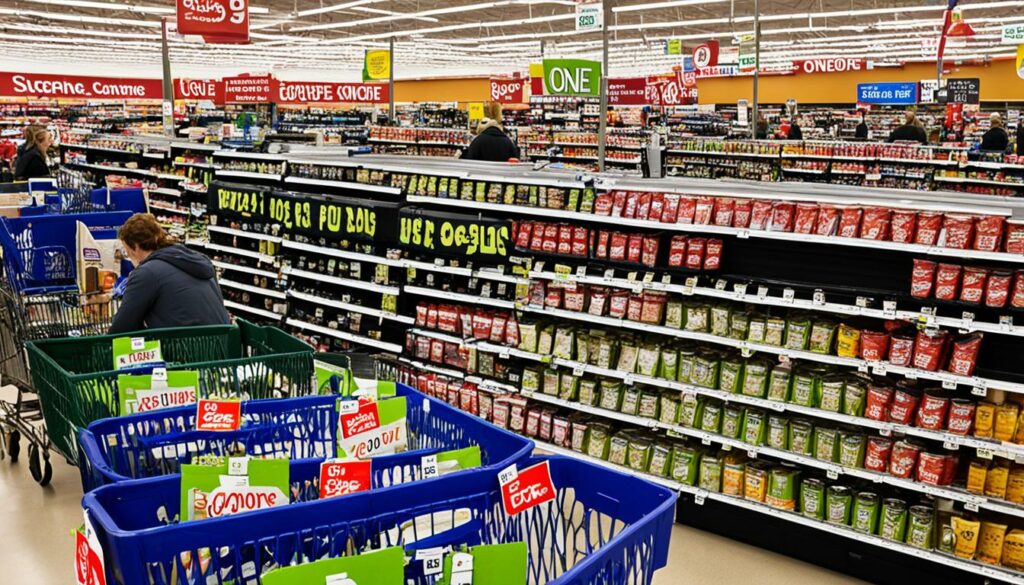
Grocery stores are known for their enticing discounts and deals that lure customers into buying more. One common tactic is offering discounts on specific items, but only when customers buy multiple quantities of the same product. This strategy taps into the consumer’s desire to save money and encourages them to buy in bulk, even if they don’t actually need that much of the item.
This discount trick plays on the psychology of perceived value. When shoppers see a lower price per unit for buying more, they feel like they’re getting a better deal and are inclined to purchase more of the item. The grocery store benefits from higher sales volume, while the customer may end up spending more than necessary.
For example, let’s say a grocery store offers a discount of $2 off for every 4 cans of soup purchased. Instead of buying just one or two cans, customers are prompted to buy four or more to take advantage of the discount. This can lead to a surplus of soup that may go to waste or take up valuable pantry space.
To illustrate the impact of these multiple purchase deals, let’s consider a practical example: the infamous Buy One Get One Free (BOGO) offers. While it may seem like a fantastic deal, consumers often end up buying more than they need, driving up their grocery bill and potentially wasting food. These discounts can be especially compelling for non-perishable items with long shelf lives, such as canned goods, toilet paper, or cleaning products.
Discount Trick with Multiple Purchases Example:
| Item | Regular Price | Discount Deal | Quantity | Total Savings |
|---|---|---|---|---|
| Peanut Butter (16 oz) | $3.99 | Buy 2 for $5 | 2 | $2.98 |
| Snack Crackers (8 oz) | $2.49 | Buy 3 for $6 | 3 | $1.47 |
As seen in the table above, the savings may seem substantial at first glance, but it’s essential to evaluate whether the quantity matches your actual needs. Buying more than necessary can lead to wasted food and money.
While these discounts may offer short-term savings, it’s vital to consider the long-term costs and potential wastage. Practical tips to avoid falling into the multiple purchase discount trap include:
- Create a shopping list and stick to it. Only buy what you need to avoid unnecessary purchases.
- Compare the discounted price per unit to other sizes or brands. Often, the larger quantity isn’t always the most economical option.
- Consider sharing purchases with friends or family members to split the cost and avoid overstocking.
- Check the expiration date on perishable items to ensure you can consume them before they go bad.
By being mindful of the discount tricks with multiple purchases, you can make informed decisions and avoid spending more than necessary. Remember, your goal is to save money and minimize food waste.
Tempting Impulse Items at the Checkout
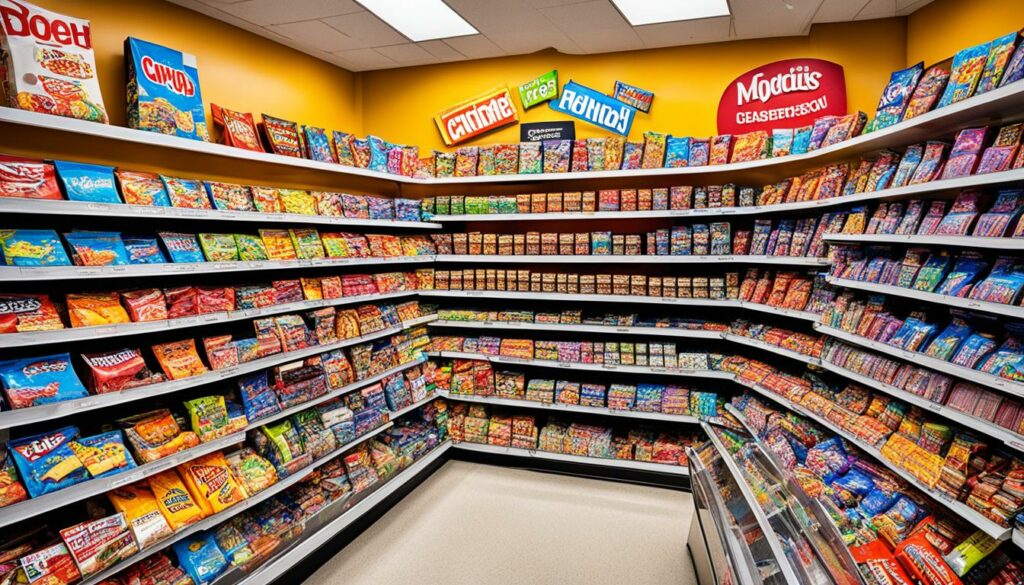
When you’re at the grocery store, have you ever found yourself reaching for a candy bar or a pack of gum at the checkout counter, even though you didn’t plan on buying it? You’re not alone. Supermarkets strategically place impulse items near the checkout area to encourage last-minute purchases.
These checkout counter items are specifically designed to capitalize on impulsive buying behavior. They are priced at a premium and strategically positioned to catch your eye while you wait in line to pay for your groceries. By placing these tempting treats within arm’s reach, supermarkets aim to entice you into making those unplanned purchases.
“The checkout counter is a prime real estate for supermarkets to generate extra sales. By displaying items like candy bars, sodas, and magazines, they create an impulse buying opportunity for customers waiting to check out.”
These impulse purchases can add up quickly, leading to unnecessary spending. While a small candy bar may seem harmless, over time, these last-minute buys can significantly impact your budget. It’s essential to be mindful of these tactics and stay focused on your shopping list to avoid falling into the impulse purchase trap.
The Power of Impulse Purchases
Impulse purchases are unplanned buying decisions made on the spot. They are often driven by emotions, desires, or the allure of a good deal. Supermarkets understand the psychology behind impulse buying and utilize it to their advantage.
At the checkout counter, you’re more likely to be in a rush, tired, or hungry, making you susceptible to these temptations. The combination of convenience, attractive packaging, and the promise of a quick treat can weaken your resistance and convince you to make that impulsive purchase.
Additionally, supermarket chains carefully curate the selection of items displayed at the checkout counters. They choose products that have proven to be popular impulse purchases, such as candy bars, gum, magazines, and drinks. These items are often small and affordable, making it easier for consumers to justify adding them to their cart at the last minute.
Resisting the Impulse
To resist the temptation of checkout counter items and avoid unnecessary spending, it’s important to be aware of these tricks and take proactive steps:
- Create a shopping list and stick to it. By having a clear plan, you’ll be less likely to get swayed by impulse items.
- Shop with a full stomach. Hunger can make you more susceptible to impulse purchases. Grab a snack before heading to the grocery store to keep your cravings in check.
- Stay focused on your budget. Remind yourself of your financial goals and the importance of sticking to them. Avoid deviating from your planned purchases.
- Pay with cash. Carrying only the amount of money you intend to spend can help prevent impulsive buying. Leave your credit cards at home to avoid overspending.
Remember, it’s okay to treat yourself occasionally, but do so mindfully. By being conscious of the impulse buying tactics employed by supermarkets, you can make more informed decisions and stay true to your budget.
| Impulse Items at the Checkout Counter | Price |
|---|---|
| Candy Bars | $1.99 |
| Gum | $0.99 |
| Magazines | $4.99 |
| Bottled Beverages | $2.50 |
Table: Examples of impulse items found at the checkout counter, along with their prices.
Changing Store Layouts to Confuse Customers
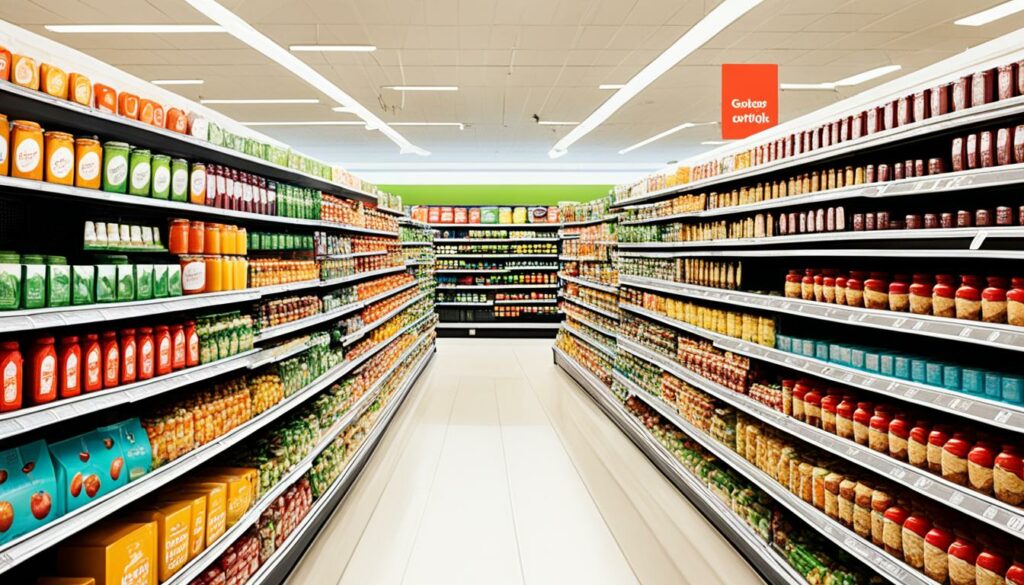
Supermarkets are known for their strategic tactics to maximize sales, and one such tactic involves regularly changing store layouts. By rearranging aisle locations, supermarkets aim to confuse customers and prolong their shopping experience.
This intentional confusion serves a specific purpose in the world of retail. When customers are disoriented and spend more time searching for products, they are more likely to make impulse purchases or add extra items to their carts.
“Store layouts play a crucial role in customer behavior,” says Sarah Johnson, a retail expert at Market Insights LLC. “By changing the layout periodically, supermarkets disrupt customers’ shopping habits and encourage them to explore different sections of the store, increasing their chances of stumbling upon items they might not have originally intended to buy.”
This tactic aligns with the supermarket’s ultimate goal of maximizing sales. When customers are unsure of where to find specific items, they may end up buying additional products they come across during their search.
Furthermore, changing store layouts helps supermarkets to stay ahead of consumer expectations. By periodically rearranging the aisles, supermarkets prevent customers from becoming too familiar with the store’s layout. This keeps shopping experiences fresh and engaging, enticing customers to explore and potentially spend more.
| Benefits of Changing Store Layouts | Drawbacks of Changing Store Layouts |
|---|---|
|
|
Despite the potential drawbacks, changing store layouts remains a popular strategy among supermarkets. It allows them to constantly adapt to consumer behavior and keep shoppers engaged.
Next, let’s explore how the size of shopping carts can influence customer behavior and encourage impulse purchases.
Sizing of Shopping Carts
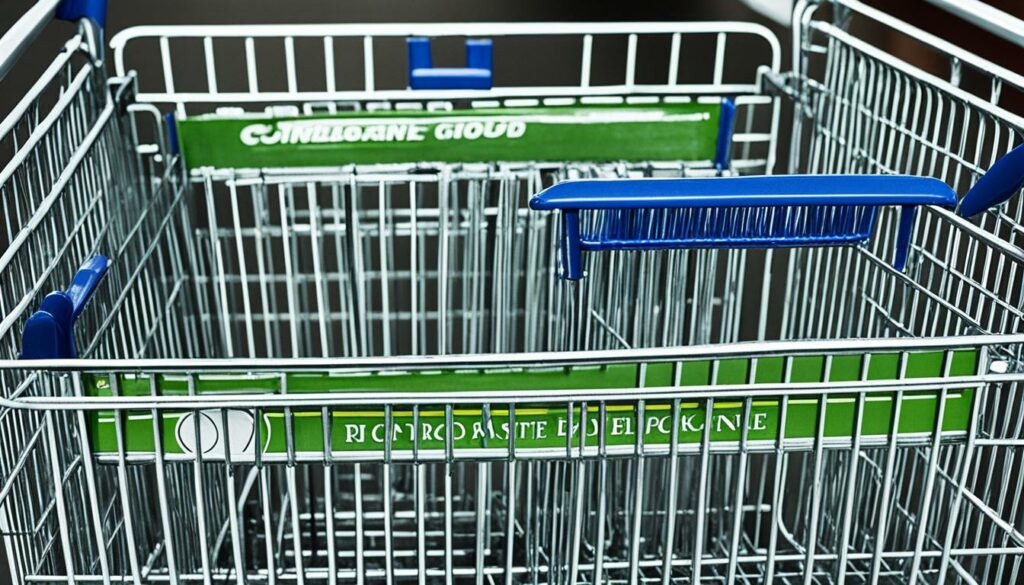
When you walk into a supermarket, have you ever noticed the size of the shopping carts? Those oversized carts aren’t just a convenience; they’re a clever tactic supermarkets use to influence your buying behavior. The shopping cart size plays a significant role in consumer psychology and can lead to more impulse purchases.
Supermarkets understand that the larger the shopping cart, the more likely you are to fill it up. It’s a psychological trick that taps into our desire to maximize our shopping experience. When faced with a spacious cart, we subconsciously feel the urge to fill it to its capacity, which often leads to adding unplanned items to our carts.
Research has shown that the size of the shopping cart can have a substantial impact on our purchasing decisions. In a study conducted by Retail Psychology Journal, researchers discovered that shoppers with larger carts spent 58% more than those with smaller carts.
The larger carts give us a false sense of need. With all that extra space, it’s easy to justify adding a few extra items to our cart. It’s as if the cart is telling us, “Go ahead, you have the room,” encouraging us to give in to impulse purchases.
“The larger the cart, the more likely customers are to make unplanned purchases.”
So, how can you resist falling into this trap? One way is to be mindful of your shopping list and stick to it. Before heading to the store, take some time to plan your purchases and only buy what you need. By having a clear list, you’ll be less likely to succumb to the temptation of filling up a larger cart with unnecessary items.
Another strategy is to opt for a smaller cart if available. Many supermarkets offer a variety of cart sizes to choose from. By selecting a smaller cart, you limit the amount of space available and reduce the temptation to make impulse purchases.
Benefits of Using a Smaller Cart
- You’re less likely to overspend and stick to your budget.
- You’ll avoid cluttering your home with unnecessary items.
- You’ll make more intentional and thoughtful purchasing decisions.
- You’ll save time by focusing on the items you truly need.
By being aware of the influence of shopping cart size on your shopping behavior, you can take control of your purchases and make more conscious decisions. Don’t let the size of the cart dictate your shopping experience. Remember, it’s not about quantity, but the quality of items you choose to bring home.
| Shopping Cart Size | Effect on Spending |
|---|---|
| Oversized Cart | Encourages impulse purchases, resulting in higher spending. |
| Smaller Cart | Promotes intentional and budget-conscious shopping, leading to controlled spending. |
Seasonal Items and Impulse Buys

Supermarkets understand the power of temptation, and one way they capitalize on it is by strategically placing seasonal treats throughout the store.
“The sights and smells of seasonal treats evoke feelings of nostalgia and excitement, making customers more likely to give in to impulse purchases,” says retail expert Jane Simmons.
As you navigate the aisles, you may come across displays of Halloween candies, Thanksgiving pies, or Valentine’s Day chocolates. These items act as distractions, tempting you to deviate from your original shopping list and indulge in these seasonal delights.
Supermarkets strategically place these items near high-traffic areas and popular sections of the store, such as the entrance, checkout counters, or endcaps, where they can easily catch your eye. This strategic placement ensures that seasonal treats remain in your line of sight, increasing the likelihood of impulse purchases.
| Tactic | Impulse Buy? | |
|---|---|---|
| Placing seasonal treats near the store entrance | ✔️ | |
| Displaying seasonal items at checkout counters | ✔️ | |
| Featuring seasonal treats on endcaps | ✔️ |
By strategically placing seasonal items throughout the store, supermarkets appeal to customers’ desires and increase the likelihood of impulse purchases. Remember, it’s important to stay mindful of your budget and shopping list to avoid succumbing to these tempting treats.
The Influence of Scents
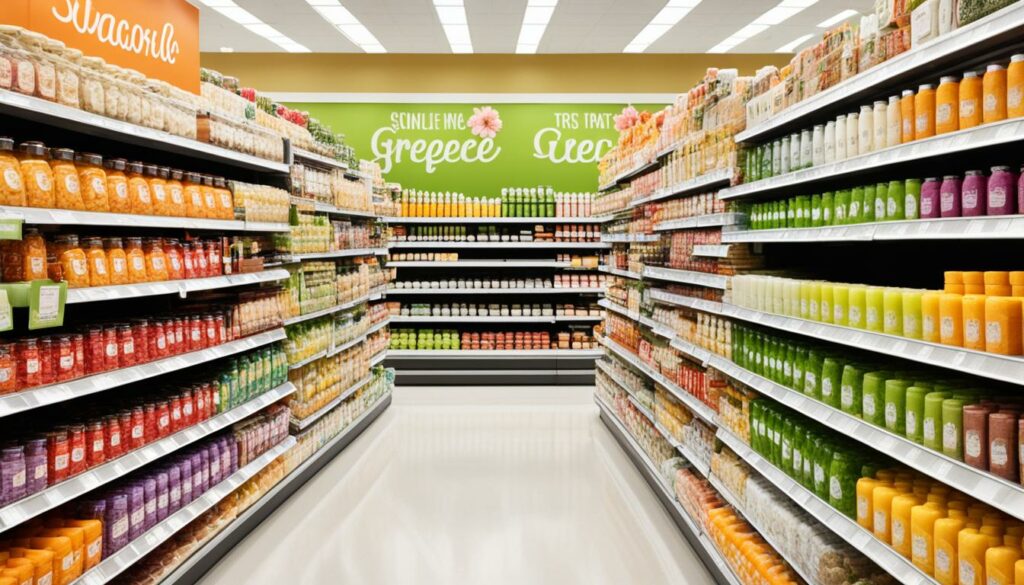
Supermarkets understand the power of scents in creating an inviting atmosphere and influencing customer buying behavior. By strategically using scents throughout the store, grocery retailers can attract customers to specific sections and increase their likelihood of making purchases.
Research has shown that certain scents, such as the aroma of fresh-baked goods, can evoke positive emotions and trigger cravings in shoppers. When customers sense the delightful fragrance of freshly baked bread or cookies, they are more likely to be drawn towards the bakery section, leading to increased sales in that area.
Moreover, scent marketing can create a multisensory experience for shoppers, enhancing their overall perception of the store. When a pleasant aroma is present, customers may perceive the environment as more welcoming and enjoyable, which can positively impact their shopping experience.
However, it’s important for grocery stores to use scents strategically and in moderation. Overwhelming or artificial scents may have the opposite effect, driving customers away instead of attracting them. Additionally, it’s crucial for retailers to consider any potential allergies or sensitivities that customers may have when using scents in their stores.
Overall, scent marketing is a powerful tool that supermarkets utilize to influence customer behavior and maximize sales. By creating an appealing olfactory environment, grocery retailers can create a more pleasant and enticing shopping experience, enhancing the potential for increased purchases.
Strategic Shelf Placement
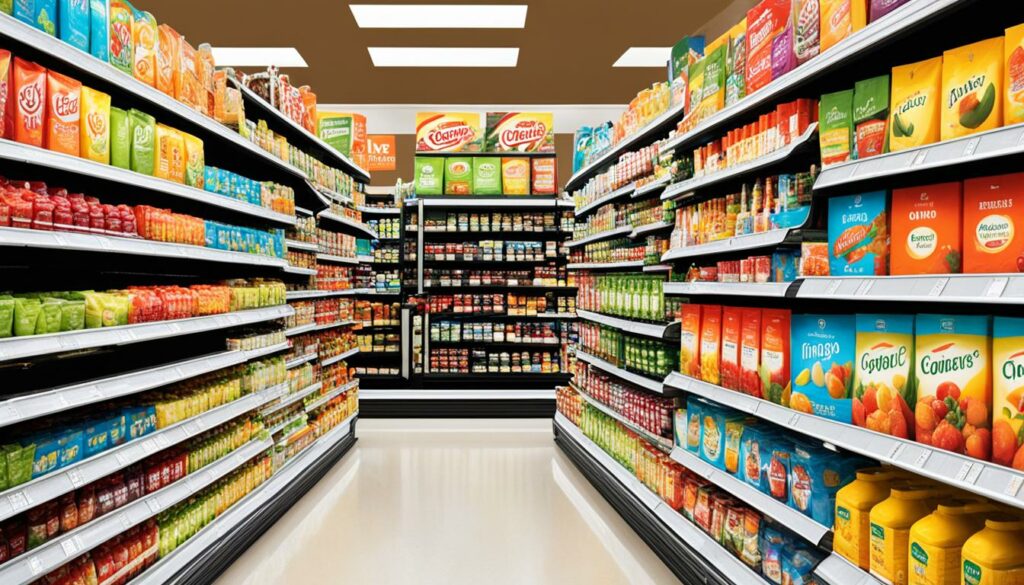
Supermarkets employ strategic shelf placement to maximize sales and influence consumer behavior. One effective tactic is positioning products at eye level, particularly those targeting children. This method capitalizes on children’s natural curiosity and impulse to grab items they can easily see.
For instance, sugary cereals and snacks are often strategically placed at a child’s eye level, enticing them to beg their parents for these items. The colorful packaging and appealing characters further attract young consumers, increasing the likelihood of a purchase.
However, supermarkets can also utilize shelf placement to promote healthier options and influence customers to make better choices. By positioning nutritious products, such as fruits, vegetables, and whole grains, at eye level, stores encourage customers to prioritize healthier alternatives. This tactic contributes to promoting a balanced diet and combating the prevalence of unhealthy eating habits.
It is crucial for shoppers, both parents and individuals, to be aware of this strategy and consciously consider the placement of products on the shelves. By engaging in mindful shopping and being informed about the marketing techniques employed by supermarkets, consumers can make healthier choices for themselves and their families.
The Impact of Music on Shopping Behavior
When you enter a supermarket, you might notice the soft background music playing throughout the store. Have you ever wondered why that is? It’s not just for decoration or ambiance; supermarkets play music strategically to influence your spending habits.
Research has shown that music has a significant impact on customer behavior in supermarkets. It can create a particular atmosphere and influence your mood, making you more likely to spend money. Stores use this knowledge of consumer psychology to their advantage, carefully selecting the right tunes to sway your shopping decisions.
According to a study conducted by the Journal of Retailing and Consumer Services, shoppers tend to buy approximately 10% more when background music is played during weekdays but not on weekends. The pleasant melodies uplift shoppers’ moods and create a more positive shopping experience, leading to increased spending.
How Music Affects Consumer Behavior
Music has the power to influence your emotions, which ultimately affects your decision-making process. By playing enjoyable tunes, supermarkets tap into your subconscious and make your shopping experience more intuitive. Here are a few ways music can influence your behavior:
- Mood enhancement: Pleasant music can uplift your mood, making you feel happier and more relaxed during your shopping trip. This positive emotional state can lead to increased impulsivity and a greater willingness to make purchases.
- Timing and pace: Supermarkets carefully select music with a specific tempo to control the flow of shoppers. Upbeat songs can subconsciously encourage you to move quickly throughout the store, reducing the chances of impulse buys. Slower melodies, on the other hand, can make you browse longer and potentially add more items to your cart.
- Product association: Music can invoke emotions and memories associated with specific products. By playing songs that align with certain product categories, supermarkets can trigger your desire for those items. For example, if relaxing music is playing near the wine section, you might be more inclined to purchase a bottle or two.
The Dance of Consumer Psychology and Music
“Music has a powerful influence on human emotions. When combined with effective marketing strategies, it becomes a potent tool for supermarkets to guide consumer behavior and increase their sales.”
Music in supermarkets is a clever manipulation of consumer psychology. By selecting the right genre, tempo, and timing, supermarkets can create an environment that enhances your shopping experience and leads you to spend more money. It’s a strategic dance between the rhythm of the melodies and the desires of the consumer.
The Influence of Music on Shopping Behavior
| Music Influence | Impact |
|---|---|
| Increased spending | Shoppers tend to buy approximately 10% more when background music is played during weekdays but not on weekends. |
| Mood enhancement | Pleasant music uplifts shoppers’ moods, leading to a more positive shopping experience and increased impulsivity. |
| Timing and pace | Music with specific tempos can control the flow of shoppers, encouraging them to move quickly or browse longer. |
| Product association | Music can invoke emotions and memories associated with specific products, increasing the desire to purchase them. |
As you navigate the aisles of your favorite supermarket, be mindful of the melodies playing overhead. While the music might be enjoyable, remember that it is also a subtle tool used to influence your spending behavior. Stay aware of these tactics and make conscious shopping decisions based on your needs and budget.
The Checkout Aisle Dilemma
When you approach the checkout aisle at the grocery store, you’re often met with a tempting display of inexpensive snacks like candy bars and chips. These items are strategically placed to encourage impulse purchases as you wait to pay for your groceries. The convenience and visibility of these checkout aisle items make it hard to resist snacking on the go.
However, in response to growing consumer demand for healthier options, some grocery stores are starting to offer alternatives to the typical impulse snacks. You may now find fresh fruits, nuts, granola bars, and other healthier choices conveniently placed alongside the traditional treats. Opting for these healthier options can help you avoid unnecessary purchases and make better choices for your overall well-being.
By choosing a nutritious snack instead of a candy bar, you can satisfy your cravings while maintaining a balanced diet. These healthier alternatives not only provide you with essential nutrients but also keep you feeling energized throughout the day.
It’s important to remember that you have control over your decisions at the checkout aisle. Take a moment to reflect on your choices and consider the impact they may have on your health. By making conscious decisions and opting for healthier options, you can resist the temptation of impulse snacks and make choices that align with your well-being.
Conclusion
Grocery store manipulation is a widespread practice aimed at encouraging consumers to spend more money. However, by being informed and aware of the tactics used by supermarkets, you can make more informed shopping decisions and protect your wallet.
To resist impulse buys and the tricks of grocery store manipulation, it’s important to create a shopping list and stick to it. By planning your purchases in advance, you can avoid unnecessary items and stay within your budget. Additionally, shopping on a full stomach can help you resist the temptation of buying items you don’t really need or want.
Consumer awareness is key in navigating the tricks employed by supermarkets. Understanding the strategic placement of items, the influence of scents, and the impact of music can help you make conscious choices. By staying alert and questioning your buying decisions, you can avoid falling into the trap of grocery store manipulation and make purchases that align with your needs and preferences.
Remember, your informed shopping choices have the power to save you money and make a positive impact on your overall well-being. Stay aware, stay informed, and take control of your grocery shopping experience.
FAQ
How do grocery stores manipulate consumer behavior?
Grocery stores use various tactics such as strategic placement of items, discounts on multiple purchases, and tempting impulse items at the checkout to encourage customers to spend more money.
Why do supermarkets locate essential items at the back of the store?
Supermarkets place essential items like milk and dairy products at the back of the store to force shoppers to navigate through the entire store, increasing the chances of making extra purchases.
How do grocery stores use discounts to trick customers?
Grocery stores often offer discounts on multiple quantities of the same item, encouraging customers to buy more than they actually need to avail of the discount.
Why do supermarkets place impulse items near the checkout counter?
Supermarkets strategically place candy bars, soda, and other impulse items near the checkout counter to capitalize on impulsive buying behavior and encourage last-minute purchases.
Why do supermarkets regularly rearrange their store layouts?
Some supermarkets regularly rearrange their store layouts to confuse customers and make them spend more time searching for products, increasing the chances of impulse buying or adding extra items to their cart.
How do the size of shopping carts influence customer behavior?
Supermarkets provide oversized shopping carts, which subconsciously encourage customers to fill them up with more items. The larger the cart, the more likely customers are to make unplanned purchases.
Why do supermarkets place seasonal items throughout the store?
Supermarkets strategically place seasonal items throughout the store to appeal to customers’ desires and increase the likelihood of impulse purchases. These items act as a distraction and tempt customers to buy treats they hadn’t planned on.
How do scents influence customer purchasing decisions in supermarkets?
Supermarkets use scents such as fresh-baked goods to create an inviting atmosphere and influence customer behavior. Pleasant scents can attract customers to specific sections of the store and increase their likelihood of making purchases.
Why are products strategically placed at eye level in supermarkets?
Supermarkets place products, especially those targeting children, at eye level to increase sales. Placing sugary cereals at a child’s eye level makes it more likely that they will beg their parents to buy them. However, supermarkets can also use shelf placement to promote healthier options and influence customers to make better choices.
How does music impact shopping behavior in supermarkets?
Research has shown that shoppers tend to buy 10% more when music is played during weekdays but not on weekends. Pleasant music uplifts shoppers’ moods and makes their decision-making more intuitive, leading to increased spending.
Why do grocery stores place snacks in the checkout aisles?
supermarkets place inexpensive snacks like candy bars and chips in the checkout aisles to tempt impulse purchases. However, some grocery stores now offer healthier snack options at their checkouts as a response to consumer demand, promoting a balanced diet.
How can consumers resist the deceptive tricks employed by grocery stores?
To resist the psychological tricks used by supermarkets, it is important to create a shopping list and stick to it. It is also advisable to avoid shopping on an empty stomach. By being aware of these tricks, consumers can make more informed shopping decisions, resist impulse buys, and ultimately save money.
Source Links
- https://www.fool.com/the-ascent/personal-finance/articles/4-ways-supermarkets-trick-you-into-spending-extra-money/
- https://nypost.com/2023/06/14/how-supermarkets-trick-you-into-spending-more/
- https://www.washingtonpost.com/lifestyle/wellness/if-you-think-grocery-stores-are-playing-tricks-on-you-they-really-are/2018/01/05/4c49450a-deb2-11e7-8679-a9728984779c_story.html
See also:
Leave a Reply